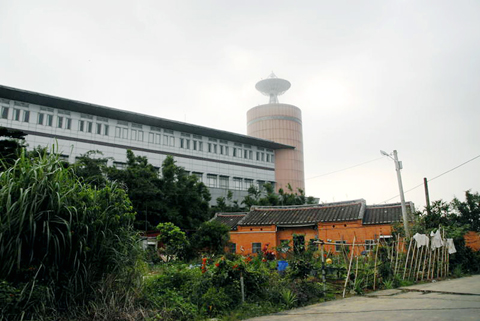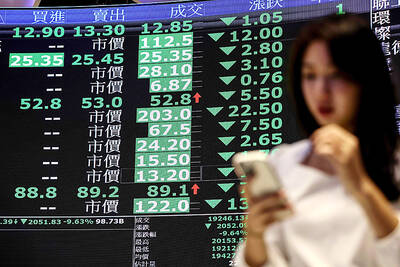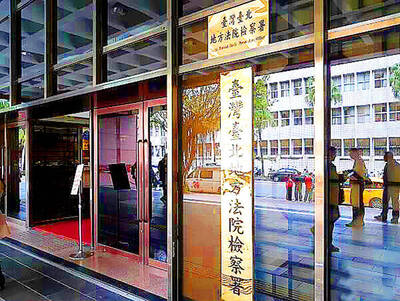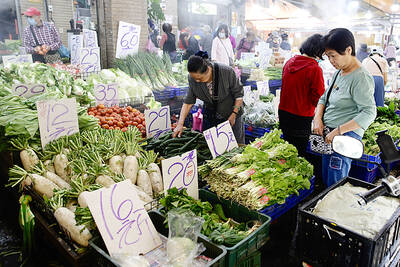Defense experts and officials in Taipei and Washington had mixed reactions to the embarrassing news, published on Monday by Defense News and Kyodo news agency, that security at a key signals intelligence facility in northern Taiwan was so lax that neighboring cows were observed walking freely around the base.
Located in Linkou (林口), Taipei County, Linyuan Base collects imagery and signals intelligence deep inside China and at sea.
The facility, which is operated by the Ministry of National Defense’s (MND) ultra-secret Office of Telecommunication Development (OTD), General Staff Headquarters, was built in 2000 and started operations in 2003, Defense News wrote.

PHOTO COURTESY OF WENDELL MINNICK
Kyodo said construction of the OTD facility cost more than NT$4 billion (US$124 million).
Consisting of a large building for data processing, barracks, a number of satellite dishes and two Circularly Disposed Antenna Arrays (CDAA), or “crop circles” that detect the direction of radio signals, the site has been described by local sources as a combination of the US’ National Security Agency (NSA) and National Reconnaissance Office.
The facility has a range of about 5,000km and can cover all of China, and the larger of the two CDAAs is still, according to Desmond Ball, a signals intelligence expert, “the most important high-frequency radio interception and direction-finding station in Taiwan.”
Ball also told Kyodo that the base is important for maritime surveillance and to track People’s Liberation Army Navy (PLAN) ships.
Despite the importance of the base, a work order by the defense ministry said the perimeter fence is “insufficiently high,” adding “in several places, the fence has toppled over or is leaning, with cows breaching the perimeter on several occasions.”
“The fence is not serving its purpose and poses the greatest threat to base security,” the report for the upgrade project says.
Both antenna arrays are accessible either by car, unpaved roads or private land, Kyodo wrote
During a recent visit, there were no guards and no signs of surveillance cameras along the perimeter, though razor wire and some makeshift fences appeared to have been recently laid, preventing the cows from entering the premises, Kyodo reported.
On two separate visits, journalists were able to walk around the base, without being intercepted by guards.
Despite the glaring security shortcomings, an infrastructure upgrade project may not be completed until January 2012, Kyodo reported, adding that from the total budget of NT$107.3 million set aside for the upgrade, only NT$3.1 million, or 3 percent, was allotted last year, while a little more than NT$70.5 million, or 66 percent of the total budget, is to be spent this year.
Asked for comment, John Pike, director of the Global Security think tank in Washington and one of the most respected military and intelligence analysts in the US, told the Taipei Times: “Presumably, if there was an actual need for the fence, it would be in good repair. On the other hand, seriousness and sense of purpose have not always been evident in Taiwanese military preparedness.
“It could be symptomatic of a lax approach, a certain carelessness — and that’s serious,” he said.
“Letting the fence fall down does qualify as being newsworthy and needs some special explanation because it is contrary to common sense,” Pike said.
"This is troubling news,” said Toshi Yoshihara, associate professor of strategy at the US Naval War College and an expert on the PLAN. “Taiwan is already in a precarious strategic position given emerging doubts about its capacity to withstand a knockout blow from Chinese missile barrages.”
Given the facility’s role in monitoring enemy troop movement, it would likely be a primary target for such attacks by China.
“If Taiwan hopes to assert some level of sea control over its littoral environment in accord with its current naval strategy, then it needs the capabilities to maintain the maximum level of battlefield awareness at sea,” he said.
Officials with the Pentagon and the NSA refused to comment on the fence situation.
A US intelligence official said the “Taiwanese intelligence picture” was “too sensitive” to discuss even off the record.
A retired US naval officer who once held a very senior position at the Pentagon and speaking on the strict understanding of anonymity said he was particularly surprised that security had not been tightened over the past few weeks as the crisis in the Korean Peninsula developed.
With the US Navy set to join South Korea in naval exercises, Taiwan may be expected to monitor the PLAN very closely.
Speaking on condition of anonymity, a former National Security Council official under former president Chen Shui-bian’s (陳水扁) administration said no civilian officials, be they from the Democratic Progressive Party or the Chinese Nationalist Party (KMT), have paid attention to security at the base, as it is a purely military site. Defense News said the Marine Corps’ 77th Regiment is responsible for security at Linyuan
“I paid several visits to the base,” the former official said. “Wandering cows will not pose any threat to operations at the OTD. All sensitive materials are processed in confined rooms, some even guarded.”
“The Chinese tourist [Ma Zhongfei, 馬中飛] who was caught in an MND recruitment center in Taipei [in May last year] is no less important than [lax security at] the OTD,” he said.
Asked to comment on the situation, ministry spokesman Yu Sy-tue (虞思祖) told the Taipei Times that he contacted the facility in Linkou and was told that the situation, including cows walking around, happened two years ago and that it has since been fixed with wire fences and that “security is now good.”
The Defense News and Kyodo reporters conducted their latest trip to Linyuan one week ago.
ADDITIONAL REPORTING BY RICH CHANG

Intelligence agents have recorded 510,000 instances of “controversial information” being spread online by the Chinese Communist Party (CCP) so far this year, the National Security Bureau (NSB) said in a report yesterday, as it warned of artificial intelligence (AI) being employed to generate destabilizing misinformation. The bureau submitted a written report to the Legislative Yuan in preparation for National Security Bureau Director-General Tsai Ming-yen’s (蔡明彥) appearance before the Foreign Affairs and National Defense Committee today. The CCP has been using cognitive warfare to divide Taiwanese society by commenting on controversial issues such as Taiwan Semiconductor Manufacturing Co’s (TSMC, 台積電) investments in the

HELPING HAND: The steering committee of the National Stabilization Fund is expected to hold a meeting to discuss how and when to utilize the fund to help buffer the sell-off The TAIEX plunged 2,065.87 points, or 9.7 percent, to close at 19,232.35 yesterday, the highest single-day percentage loss on record, as investors braced for US President Donald Trump’s tariffs after an extended holiday weekend. Amid the pessimistic atmosphere, 945 listed companies led by large-cap stocks — including Taiwan Semiconductor Manufacturing Co (TSMC, 台積電), Hon Hai Precision Industry Co (鴻海精密) and Largan Precision Co (大立光) — fell by the daily maximum of 10 percent at the close, Taiwan Stock Exchange data showed. The number of listed companies ending limit-down set a new record, the exchange said. The TAIEX plunged by daily maxiumu in just

INVESTIGATION: The case is the latest instance of a DPP figure being implicated in an espionage network accused of allegedly leaking information to Chinese intelligence Democratic Progressive Party (DPP) member Ho Jen-chieh (何仁傑) was detained and held incommunicado yesterday on suspicion of spying for China during his tenure as assistant to then-minister of foreign affairs Joseph Wu (吳釗燮). The Taipei District Prosecutors’ Office said Ho was implicated during its investigation into alleged spying activities by former Presidential Office consultant Wu Shang-yu (吳尚雨). Prosecutors said there is reason to believe Ho breached the National Security Act (國家安全法) by leaking classified Ministry of Foreign Affairs information to Chinese intelligence. Following interrogation, prosecutors petitioned the Taipei District Court to detain Ho, citing concerns over potential collusion or tampering of evidence. The

‘COMPREHENSIVE PLAN’: Lin Chia-lung said that the government was ready to talk about a variety of issues, including investment in and purchases from the US The National Stabilization Fund (NSF) yesterday announced that it would step in to staunch stock market losses for the ninth time in the nation’s history. An NSF board meeting, originally scheduled for Monday next week, was moved to yesterday after stocks plummeted in the wake of US President Donald Trump’s announcement of 32 percent tariffs on Taiwan on Wednesday last week. Board members voted to support the stock market with the NT$500 billion (US$15.15 billion) fund, with injections of funds to begin as soon as today. The NSF in 2000 injected NT$120 billion to stabilize stocks, the most ever. The lowest amount it